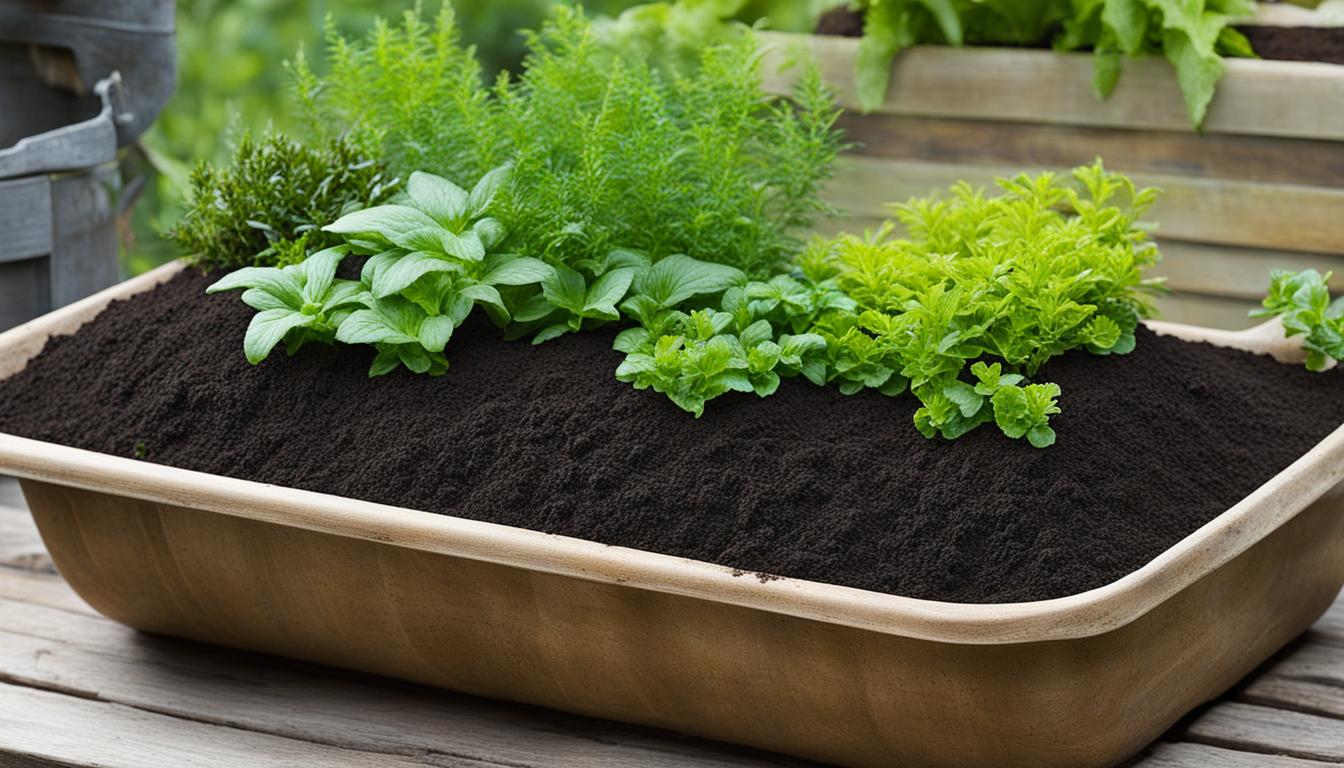
When it comes to container gardening, selecting the right soil mix is crucial for the health and success of your plants. It’s important to understand that not all soils are suitable for container gardening, as they may not provide the necessary nutrients, drainage, and aeration that potted plants require.
In this comprehensive guide, I will explore the best soil options for container gardening and provide tips on how to choose the right soil for your specific needs.
Key Takeaways:
- Choosing the right soil mix is essential for the health and success of your container garden.
- Not all soils are suitable for container gardening, as they may lack the proper nutrients, drainage, and aeration.
- It is important to use a good all-purpose potting soil that provides the optimal balance of moisture retention, drainage, and nutrient availability.
- Avoid using garden soil or topsoil in your containers, as they can lead to compaction, poor drainage, and nutrient imbalances.
- Regular fertilization and periodic soil refreshment are necessary to maintain the health and fertility of your container garden.
The Importance of Good Soil for Container Gardening
The soil used in container gardening plays a crucial role in the overall health and growth of your plants. Unlike plants grown in the ground, container plants rely solely on the soil within their confined space for nutrients, water, and oxygen.
Therefore, it is essential to provide them with a high-quality soil mix that offers proper drainage, aeration, and nutrient availability. Neglecting to use the right soil can result in poor plant growth, root rot, and other issues that can hinder the success of your container garden.
When selecting soil for container gardening, there are several key factors to consider. First and foremost, the soil should have excellent drainage properties to prevent waterlogging and root rot. Good aeration is also essential for healthy root development and oxygen circulation.
The soil should have the ability to hold moisture without becoming overly saturated, as excessive moisture can lead to plant diseases. It is also important to choose soil that is free of bugs and has a pleasant smell, indicating its quality and suitability for your container garden.
By using a high-quality soil mix specifically formulated for container gardening, you can provide your plants with the optimal growing conditions they need to thrive.
Remember to inspect the soil before purchasing, looking for lightweight, fluffy consistency and the absence of bugs. With the right soil and proper care, you can create a vibrant and flourishing container garden.
What Not to Use in Your Container Garden
When it comes to container gardening, the type of soil you use can make or break the success of your plants. While it may be tempting to use garden soil or topsoil in your containers, it is important to understand that these options are not suitable for potted plants.
Garden soil is often heavy and can lead to compaction, restricted root growth, and poor drainage. It may also contain spores, seeds, and diseases that can harm your plants. Topsoil, on the other hand, lacks the necessary nutrients and structure for container gardening.
Instead of using garden soil or topsoil, it is best to opt for a specialized potting mix that is specifically formulated for container gardening. These mixes provide the ideal balance of drainage, aeration, and nutrient availability for potted plants.
What Not to Use in Your Container Garden
| Soil Type | Issues |
|---|---|
| Garden soil | Heavy, poor drainage, may contain spores, seeds, and diseases |
| Topsoil | Lacks nutrients and structure for container gardening |
Choosing the Best Soil Mix for Your Containers
When it comes to container gardening, selecting the best soil mix is crucial for the success of your plants. The right soil provides your container plants with the essential nutrients, drainage, and aeration they need to thrive.
The best soil mix for container gardening is a good all-purpose potting soil. This type of soil is specifically formulated to provide the optimal balance of drainage, aeration, and nutrient retention.
When selecting a potting soil, look for one that is lightweight and fluffy, as this allows for proper root development and oxygen circulation. It should also have good moisture retention without becoming waterlogged, as excessive moisture can lead to root rot.
Inspecting the soil before purchasing is essential to ensure its quality and suitability for your container garden. The soil should be free of bugs and have a pleasant earthy smell.
To further customize your soil mix, you can add organic matter such as compost or worm castings to enhance nutrient content.
You can incorporate vermiculite or perlite to improve aeration and moisture retention. These additives help create an optimal growing environment for your container plants.
Comparison of Popular Potting Soil Brands
| Brand | Weight | Drainage | Nutrient Retention | Price |
|---|---|---|---|---|
| Brand A | Lightweight | Good | Excellent | $ |
| Brand B | Medium | Fair | Good | $$ |
| Brand C | Heavy | Poor | Fair | $$$ |
Table: Comparison of popular potting soil brands based on weight, drainage, nutrient retention, and price.
Note: The weight refers to the overall density of the soil, with lightweight being preferable for ease of handling and root development. Drainage indicates how well the soil allows excess water to pass through, while nutrient retention refers to the soil’s ability to hold and release nutrients to the plants. Price is a general indication of the cost of the soil mix.
What to Look for in the Perfect Soil
The perfect soil for container gardening should meet certain criteria to provide the best growing conditions for your plants. Here are some key factors to consider:
- Texture: The soil should be light and fluffy, allowing for proper root development and oxygen circulation. Sandy or compacted soil may hinder plant growth.
- Moisture Retention: The soil should have good moisture retention without becoming waterlogged. Excessive moisture can lead to root rot and other plant diseases.
- Drainage: Proper drainage is crucial to prevent waterlogging and ensure healthy root growth. Look for a soil mix that allows excess water to flow freely.
- Bug-Free: Inspect the soil for bugs or pests before purchasing. Avoid soil that shows signs of infestation, as it may introduce harmful organisms to your container garden.
- Pleasant Smell: A good soil mix should have a pleasant earthy smell, indicating its quality and freshness.
By selecting soil that meets these criteria, you can provide your container plants with the ideal growing conditions for optimal health and vitality.
Comparison of Different Soil Mixes
| Soil Mix | Texture | Moisture Retention | Drainage | Bug-Free | Pleasant Smell |
|---|---|---|---|---|---|
| All-Purpose Potting Soil | Light and fluffy | Good moisture retention | Proper drainage | Bug-free | Pleasant earthy smell |
| Garden Soil | Heavy and compacted | Poor moisture retention | Inadequate drainage | Potential for pests and diseases | Varies |
| Topsoil | Varies | Poor moisture retention | Inadequate drainage | Potential for pests and diseases | Varies |
This table provides a comparison of different soil mixes commonly used in container gardening. As you can see, all-purpose potting soil meets the desired criteria for container gardening, while garden soil and topsoil have limitations that make them less suitable for potted plants.
Remember, the quality of the soil is crucial for the health and success of your container garden. By selecting the right soil mix and ensuring it meets the necessary criteria, you can create an ideal growing environment for your plants.
Preparing Your Containers for Planting
Before planting in your containers, it is important to properly prepare them to create an ideal environment for your plants. Whether you are reusing pots or starting with new ones, a few simple steps can make a big difference in the success of your container garden.
1. Clean your containers:
If you are reusing pots, it is crucial to clean them thoroughly before planting. Remove any old soil or plant debris, and scrub the containers with a mild detergent and water. This helps prevent the buildup of diseases and pests that can harm your new plants.
2. Fill your containers:
When adding soil to your containers, fill them to within an inch of the top. This allows enough space for plant roots and additional soil if needed. If you are planting seeds, fill the container a bit higher, about half an inch from the top. This provides ample space for the seeds to germinate and grow.
3. Consider drainage:
Proper drainage is essential for container gardening success. Make sure your containers have drainage holes at the bottom to allow excess water to escape. If your pots do not have pre-drilled holes, you can create them using a drill or hammer and nail.
Also, placing a layer of rocks or gravel at the bottom of the container before adding soil can further improve drainage.
By following these simple steps, you can ensure that your containers are ready for planting and provide the best possible growing environment for your plants.
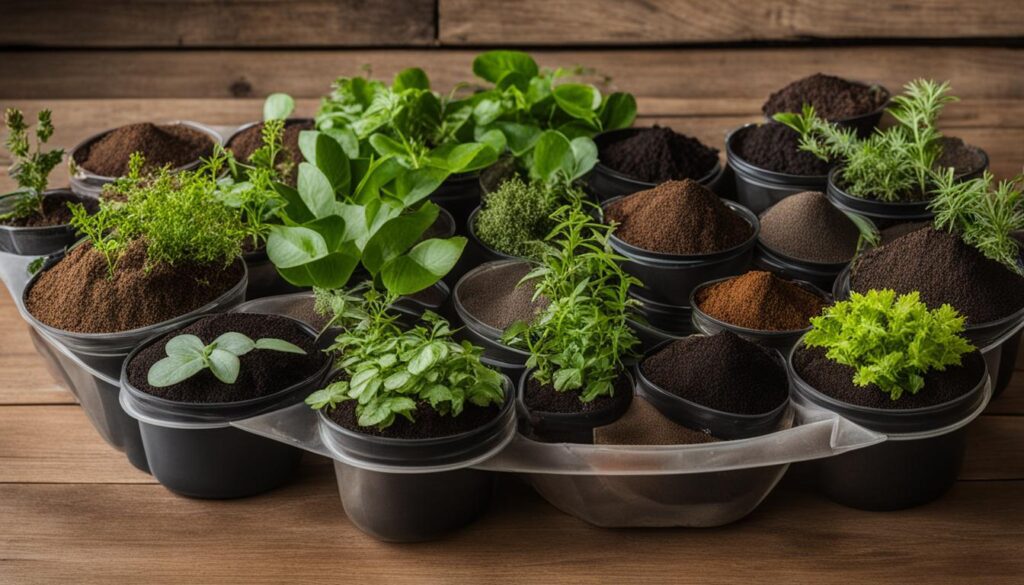
| Step | Description |
|---|---|
| 1 | Clean your containers |
| 2 | Fill your containers |
| 3 | Consider drainage |
The Importance of Fertilizing Your Container Garden
When it comes to container gardening, fertilizing plays a crucial role in ensuring the health and vitality of your plants. While a good potting soil provides essential nutrients, regular fertilization is necessary to replenish these nutrients that can be washed out through frequent watering.
By fertilizing your container garden, you can ensure that your plants receive the necessary nutrients for healthy growth and abundant blooms.
Organic vegetable granular fertilizer is a popular choice for container gardens. It provides a balanced mix of nutrients without the risk of chemical buildup. When applying fertilizer, it’s important to follow the instructions on the packaging to avoid over-fertilizing, which can be harmful to your plants.
Remember to water your container garden thoroughly after fertilizing to help the nutrients penetrate the soil and reach the plant roots.
In addition to regular fertilization, it’s also important to monitor your plants for signs of nutrient deficiencies. Yellowing leaves, stunted growth, and poor flowering can indicate a lack of nutrients.
If you notice these symptoms, consider adjusting your fertilization routine or using a specialized fertilizer formulated for the specific needs of your plants.
Common Nutrients and their Functions for Container Gardens
| Nutrient | Function |
|---|---|
| Nitrogen (N) | Promotes leaf and stem growth |
| Phosphorus (P) | Stimulates root development and flower production |
| Potassium (K) | Aids in overall plant health, disease resistance, and water uptake |
| Calcium (Ca) | Strengthens cell walls and prevents blossom end rot in tomatoes |
| Magnesium (Mg) | Essential for the production of chlorophyll and overall plant vigor |
| Sulfur (S) | Helps with protein synthesis and overall plant health |
By understanding the importance of fertilizing and providing the necessary nutrients for your container garden, you can ensure that your plants thrive and produce beautiful blooms throughout the growing season.
Remember to choose the right fertilizer, follow the instructions for application, and monitor your plants for any signs of nutrient deficiencies. With proper fertilization, your container garden will flourish and provide you with endless joy and satisfaction.
The Importance of Using the Right Soil for Container Gardening
When it comes to container gardening, the type of soil you choose plays a vital role in the success of your plants. Using the right soil mix ensures that your plants have access to essential nutrients, proper drainage, and optimal root development.
While compost and garden soil may seem like viable options, they are not suitable as a sole growing medium for container plants. Instead, it is best to use a specialized potting soil or potting mix. These blends are formulated to provide the ideal balance of nutrients, aeration, and drainage for container gardening.
Compost and garden soil can be beneficial when mixed with other components, such as peat moss or perlite. However, using them alone can lead to compaction, poor drainage, and nutrient imbalances.
Specialized potting soil or potting mix, on the other hand, is designed to meet the specific needs of potted plants. It provides a lightweight and well-draining environment, allowing roots to access oxygen and nutrients. By using the right soil for container gardening, you can set your plants up for healthy growth and abundant yields.
| Soil Type | Pros | Cons |
|---|---|---|
| Potting Soil | – Specifically formulated for container plants – Provides adequate drainage and aeration – Contains essential nutrients | – Can be more expensive compared to other options |
| Compost | – Adds organic matter and nutrients to the soil – Improves soil structure and moisture retention | – Can be heavy and retain too much moisture if used alone – May contain weed seeds or pathogens |
| Garden Soil | – Rich in nutrients and beneficial microorganisms | – Often too heavy for container gardening – May contain pests, diseases, or weed seeds |
As shown in the table above, potting soil offers numerous advantages for container gardening. While compost and garden soil have their benefits, they are best used in combination with other components to create a well-balanced growing medium.
It’s important to consider the specific needs of your plants and choose the appropriate soil for optimal growth. By selecting the right soil mix, you can create a thriving container garden and enjoy the beauty and bounty of your plants.
The Importance of Refreshing Your Soil Over Time
Proper soil maintenance is essential for the long-term health and productivity of your container garden. Over time, the nutrients in potting soil can become depleted, and the soil itself may break down. To ensure optimal plant growth and prevent nutrient deficiencies, it is important to refresh your soil periodically.
Refreshing your soil involves a gradual process that takes place over several years. In the first year, it is recommended to start with new potting soil when planting.
This will provide your plants with fresh nutrients and a healthy growing medium. In the second year, you can add a deep layer of compost to the top of the existing soil and continue planting. The compost will help replenish the soil’s nutrient content and improve its structure.
But, it is important to assess the quality of the compost to avoid introducing pests or diseases to your garden.
In the third year, mix the existing soil with new potting soil and a little compost when repotting your plants. This will help maintain nutrient levels and provide a balanced growing medium. Finally, in the fourth year, it is recommended to start with fresh soil again to ensure optimal plant health and minimize the risk of bug infestations.
By refreshing your soil over time, you can provide your container plants with the nutrients they need to thrive and continue producing healthy foliage and blooms. Regular soil maintenance is a key aspect of successful container gardening and should be part of your overall care routine.
Making Your Own Potting Soil Mix
Creating your own potting soil mix can be a cost-effective and customizable option for your container gardening needs. By combining specific ingredients, you can tailor the soil mix to provide optimal nutrition, drainage, and aeration for your plants.
A popular recipe for homemade potting soil includes peat moss, compost or worm castings, and vermiculite or perlite.
Peat moss is an excellent ingredient to add to your potting soil mix as it provides a light and fluffy texture. It helps with moisture retention and allows for proper root development. You can find peat moss at your local garden center or nursery.
Compost or worm castings are essential for adding nutrients to your potting soil mix. These organic materials are rich in essential nutrients that your plants need for healthy growth.
You can make your own compost by collecting kitchen scraps, yard waste, and other organic materials, or you can purchase it from a garden center.
Vermiculite or perlite are additives that help improve the drainage and aeration of your potting soil mix. They prevent the soil from becoming compacted and allow for better oxygen circulation around the roots.
Vermiculite retains moisture, while perlite enhances drainage. You can find these materials at gardening stores or nurseries.
Homemade Potting Soil Mix Recipe:
| Ingredient | Amount |
|---|---|
| Peat Moss | 2 parts |
| Compost or Worm Castings | 1 part |
| Vermiculite or Perlite | 1 part |
Combine the peat moss, compost or worm castings, and vermiculite or perlite in a large container or wheelbarrow. Mix thoroughly to ensure that all ingredients are evenly distributed. You can then use this homemade potting soil mix to fill your containers for planting.
By making your own potting soil mix, you have control over the quality and composition of the soil. This allows you to create the ideal growing conditions for your container plants, promoting healthy root development and vigorous growth.
Experiment with different ratios and ingredients to find the perfect mix that works best for your specific plants and gardening environment.
Cost-Effective Options and Sales on Potting Soil
When it comes to filling your containers with potting soil, the cost can quickly add up, especially if you’re starting a new container garden or have many plants to repot. However, there are several cost-effective options and ways to save money on potting soil without compromising the health and success of your plants.
One strategy is to research different potting soil brands and types to find the best quality at a reasonable price. Look for sales or discounts, especially as the weather warms up and gardening season begins. Many garden centers and online retailers offer promotions and bulk-buying discounts, which can significantly reduce the cost of potting soil.
Comparison of Potting Soil Prices (per cubic foot)
| Potting Soil Brand | Price (per cubic foot) |
|---|---|
| Brand A | $X.XX |
| Brand B | $X.XX |
| Brand C | $X.XX |
Another option to consider is buying potting soil in bulk. Many garden centers offer discounts when you purchase larger quantities, such as by the bag or yard. Buying in bulk not only saves you money but also ensures that you have enough potting soil for all your container gardening needs.
If you have the time and resources, making your own potting soil mix can be a cost-effective solution. By combining ingredients like peat moss, compost, vermiculite, and perlite, you can create a customized mix that meets the specific needs of your plants.
Making your own potting soil allows you to have control over the quality and composition, while also saving money in the long run.
With these cost-effective options and sales on potting soil, you can fill your containers without breaking the bank. Take advantage of discounts, buy in bulk, or consider making your own mix to save money while still providing your container plants with the high-quality soil they need.
Conclusion and Final Tips
As I conclude this guide on selecting the right soil mix for your container garden, I want to leave you with some final tips that will help you achieve success in your gardening endeavors.
Firstly, it is important to remember that container gardening requires special attention to soil composition, as potted plants rely solely on the soil within their confined space for nutrients, water, and oxygen.
So always opt for a good all-purpose potting soil that provides the necessary drainage, aeration, and nutrient retention.
Additionally, regularly fertilizing your container garden is crucial, as frequent watering can wash out essential nutrients from the soil. Choose an organic vegetable granular fertilizer and apply it according to the manufacturer’s instructions.
Lastly, don’t forget to refresh your soil over time to ensure the health and fertility of your plants. In the first year, use new potting soil when planting. In the following years, consider adding compost or mixing the existing soil with new potting soil and a little compost before repotting.
By following these container gardening soil tips and selecting the right soil mix, you will create the ideal growing conditions for your plants, leading to a thriving and beautiful container garden. Happy gardening!
FAQ
How do I select the right soil mix for container gardening?
When selecting soil for container gardening, it is important to choose a good all-purpose potting soil that offers proper drainage, aeration, and nutrient retention. Avoid using garden soil or topsoil, as they are not suitable for potted plants.
Why is good soil important for container gardening?
Good soil is crucial for container gardening because it provides the necessary nutrients, drainage, and aeration that potted plants require for healthy growth. Neglecting to use the right soil can result in poor plant growth, root rot, and other issues that can hinder the success of your container garden.
Can I use garden soil or topsoil in my container garden?
No, garden soil and topsoil are not suitable for container gardening. Garden soil is heavy and can lead to compaction and poor drainage, while topsoil lacks the necessary nutrients and structure. It is best to use a specialized potting soil or potting mix specifically formulated for container gardening.
What should I look for in the perfect soil for container gardening?
The perfect soil for container gardening should be light and fluffy, allowing for proper root development and oxygen circulation. It should also have good moisture retention without becoming waterlogged, be free of bugs, and have a pleasant smell.
How should I prepare my containers for planting?
Before planting in your containers, clean them thoroughly by removing any old soil and scrubbing them. This helps prevent the buildup of diseases and pests. When adding soil, fill the containers to within an inch of the top, leaving enough space for plant roots and additional soil if needed.
Do I need to fertilize my container garden regularly?
Yes, regular fertilization is necessary for container gardens because frequent watering can wash out nutrients from the soil. Organic vegetable granular fertilizer works well for container gardens, providing a balanced mix of nutrients without the risk of chemical buildup.
Can I use compost or garden soil alone in containers?
No, compost and garden soil alone are not suitable as a growing medium for container plants. While they can be beneficial when mixed with other components, using them on their own can lead to issues such as compaction, poor drainage, and nutrient imbalances.
How often should I refresh the soil in my container garden?
It is important to refresh the soil in your container garden periodically. In the first year, use new potting soil when planting. In the second year, you can add a deep layer of compost to the top of the existing soil. In the third year, mix the existing soil with new potting soil and a little compost before repotting. Finally, in the fourth year, start with fresh soil to ensure optimal plant health.
Can I make my own potting soil mix?
Yes, making your own potting soil mix can be a cost-effective and customizable option for container gardening. A popular recipe includes peat moss, compost or worm castings, and vermiculite or perlite. This allows you to have control over the quality and composition of the soil.
How can I save money on potting soil?
To save money on potting soil, you can research different brands and types to find sales or discounts. Buying in bulk or making your own potting mix can also help reduce costs. Taking advantage of sales and discounts is a great way to obtain quality potting soil at a more affordable price.

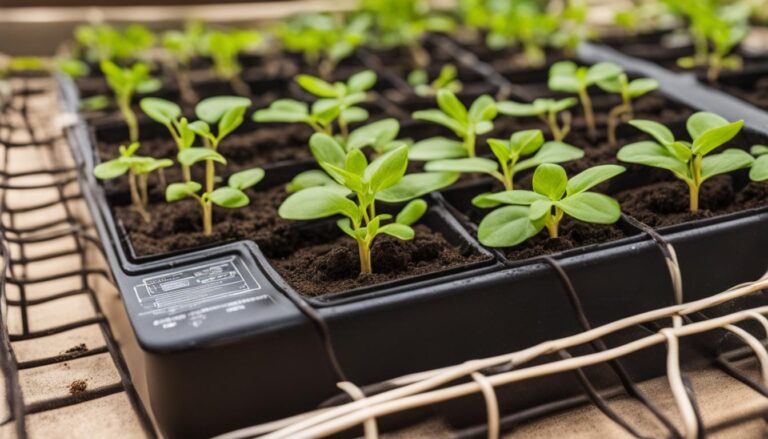
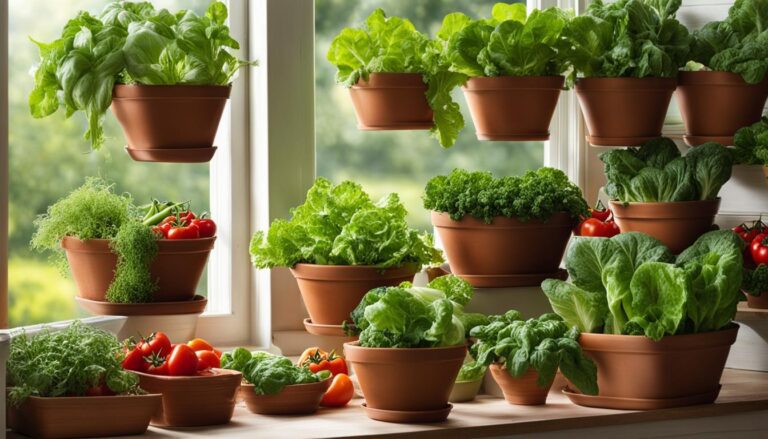
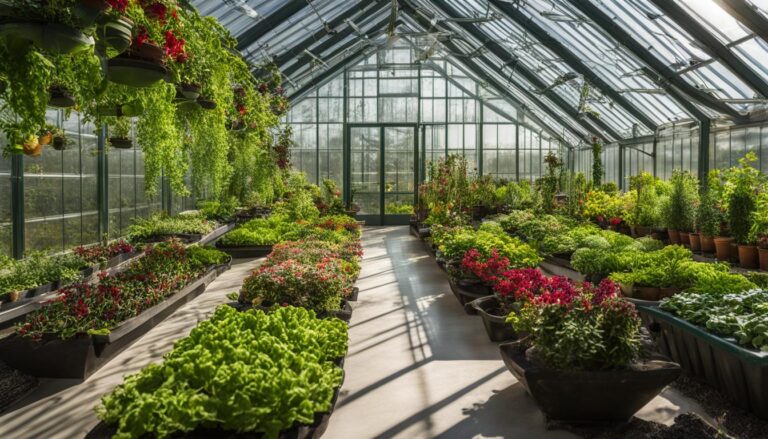
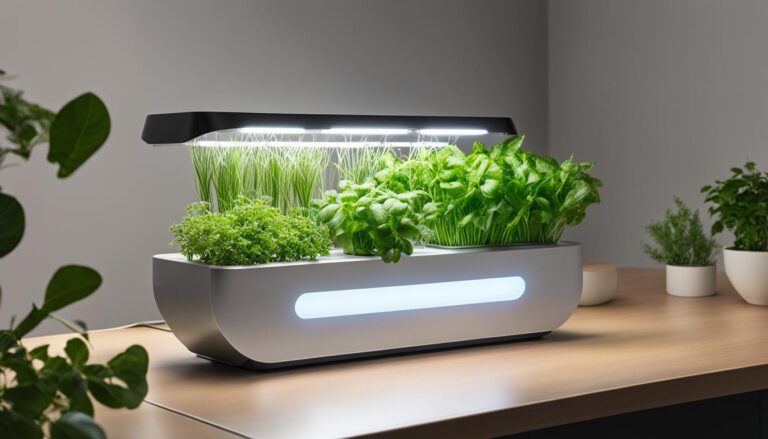
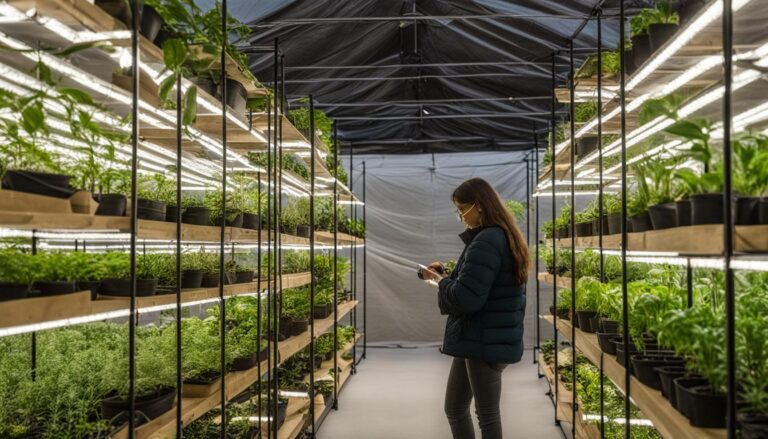
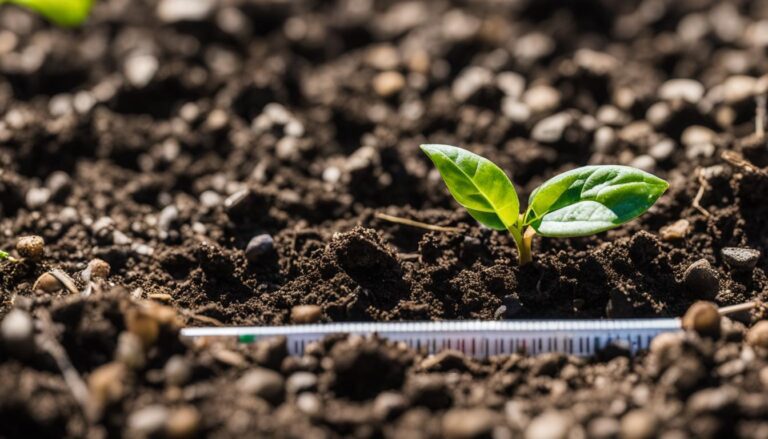
2 Comments
Comments are closed.